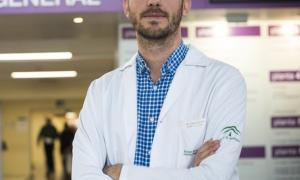The European Society for Blood and Marrow Transplantation rewards the work from the IciStem consortium at its Annual Meeting

The work is based on 2 patients included in the IciStem project, an international consortium to investigate a potential cure for HIV by bone marrow transplantation. IciStem is co-led by the IrsiCaixa AIDS Research Institute (Barcelona, Spain) and the University Medical Center Utrecht (The Netherlands).
Jon Badiola, an Hematology resident in the Virgen de las Nieves University Hospital in Granada (Spain), has been awarded with one of the Best Young Abstract Awards at the Annual Meeting of the European Society for Blood and Marrow Transplantation (EBMT), which recognizes the work of researchers under 35 years of age. Badiola’s work is integrated in the IciStem Consortium, co-led by the IrsiCaixa AIDS Research Institute (Barcelona, Spain) and by the University Medical Center Utrecht (The Netherlands). The abstract analyses factors related to bone marrow transplantation that may influence a potential cure for HIV infection.
The abstract focuses on 2 patients included in the IciStem project, an international consortium to investigate the potential for HIV cure by bone marrow transplantation. Funded by The Foundation for AIDS Research, amfAR (USA), IciStem was created after the Berlin Patient case, Timothy Brown, an HIV-positive man who in 2008 received a bone marrow transplant from a donor carrying a mutation, so-called CCR5 Delta32, which averted the virus from infecting the cells. After the transplantation, virus began to disappear in his body. Today he is cured of the leukaemia he suffered and is considered the only person cured of HIV infection.
Aiming to eliminate the reservoir
IciStem recruits HIV-infected patients with a hematologic cancer who have undergone a bone marrow transplant, in order to figure out what conditions, besides the CCR5 Delta 32 mutation, contributed to Brown’s cure. So far, 25 transplants have been carried out within the framework of the consortium. Jon Badiola presents to the EBMT a work focused on two of them transplanted in 2009 and 2013, respectively, from donors who did not have the CCR5 Delta32 mutation.
Scientists have analysed their viral reservoir, which are HIV-infected cells that remain dormant so the immune system cannot detect and destroy them. The reservoir is currently considered the main obstacle to find a cure for HIV.
A reduction of the reservoir to apparently undetectable levels has been observed in the two patients. This means that scientists are not able to find HIV in either blood or tissues, but this does not necessarily mean that virus is completely eliminated. “We cannot say that HIV has been eliminated until we stop antiretroviral treatment since the virus might rebound when drugs disappear, but it is a good indicator of the potential benefit of the transplantation,” Badiola explains.
“At the moment, bone marrow transplantation is the only medical intervention that achieved this reduction -says Javier Martínez-Picado, ICREA researcher at IrsiCaixa co-director of IciStem. This encourages us to further investigate what happened in those reservoirs after the intervention,” he adds. Martínez-Picado co-leads IciStem together with Annemarie Wensing, clinical virologist at the University Medical Center Utrecht (The Netherlands).
Collaboration between medical specialists and researchers
Badiola emphasizes that the results obtained in the consortium “are the result of collaboration between medical specialists and researchers. The advances achieved so far reflects hat this collaboration allows us to advance in fields as complex as biomedicine.”
Researchers insist that bone marrow transplantation is a high-risk procedure, so it is performed only in situations where there is no other therapeutic option to treat cancer. The goal is to investigate the factors that help to eradicate the virus and then mimic them to design new HIV cure strategies, alternatives to transplantation.